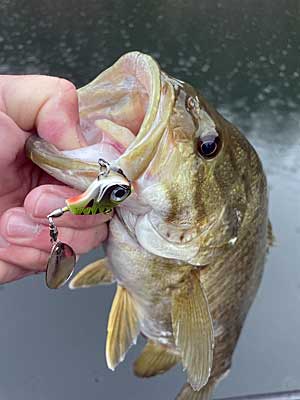
The tail spinner is one of the oldest lures around and still has plenty of fans. Going back to the old days, lures like the Mann's Little George have been catching bass for generations. They are a simple lead lure with a spinner attached to the tail, and they catch bass exceptionally well when they are schooling, chasing baitfish, and during the coldest times of the year when they are inactive and hanging near the bottom.
Part of their appeal is the simplicity of fishing them and that they can be fished at various depths and are great imitators of a small baitfish. No matter how or where you fish them, a tail spinner is a proven lure for catching bass and a hodgepodge of other predatory fish.
Selecting the Right One
There are many different brands of tail spinners available, and each looks similar, but there are plenty of differences, mainly in the vibration they create. The blade size and style play a significant role in this, but the swivel quality also affects how easily the blade spins. Some kinds of this bait have the blade swinging around a fixed wire from the bait instead of using a swivel, and while each provides flash, the models using a swivel tend to put off more vibration.
Some of the popular baits are the original Little George and modern editions like the Lunkerhunt Big Eye Tail Spin Jig and Jackall Deracoup. The latter two are more detailed with realistic finishes but do the same thing as the original.
These little baits come in various weight sizes, with the 3/8 and ½ ounce models being an excellent place to start. Going heavier has benefits when fishing very deep water or needing a very long cast to reach schooling fish. For colors, the "match the hatch" approach works, and there are many different color options to match whatever the bass are eating on your home waters.
Tail Spinnin' Gear

You can fish this style of bait with either spinning or baitcasting gear; it's up to personal preference. Since they're small and generally heavy, they cast exceptionally well on both setups.
The benefits of using baitcast gear are long casts and the ability to upsize your line more easily. Spinning gear also works well and is favored by many anglers who fish in cold weather as it is much easier to handle in frigid temps or when wearing gloves.
A seven-foot medium rod for either baitcast or spinning gear is a good starting point, and all allow enough give in the rod for fighting fish with a bait with such a small treble hook. For line, ten-to-twelve-pound fluorocarbon on casting gear or a 15-pound braided line with a ten-pound fluorocarbon leader on spinning gear is plenty for fishing a tail spinner. Using a high visibility braid like Seaguar Smackdown in the Flash Green color greatly helps detect light bites when jigging the baits near the bottom.
Techniques for Fishing Them
A tail spinner excels because the spinner does most of the work. A simple cast and retrieve will catch fish, and this is a great option when fishing near the top of the water column and down towards the bottom. It produces flash and vibration, and you can easily vary your retrieve speed and depth.

When noticing schooling fish near the surface busting on bait, one of the most frustrating things to anglers is how they always seem to be just out of reach of a standard cast. As you get closer, the school often dissipates, or you only get one good cast in. This is a time when the tail spinner works wonders simply because of how easily they cast long distances. Once near the school, simply retrieve the bait through the activity.
This same approach also works well underneath the surface when noticing baitfish and bass activity on your electronics; this same approach can be done anywhere in the water column by counting down the bait to the correct depth of what you see on your screen.
Another way to fish a tail spinner is with a lift and drop retrieve, and it's one of the deadliest techniques in cold weather, similar to a blade bait. The metal baits appeal to cold water fish and perfectly imitate a dying baitfish. Plus, since all of the baits are generally compact and heavy, they sink quickly and can be fished as deep as you like. Offshore rockpiles and humps, steep drop-offs, and main lake points are good areas to use late in the season.
For tail spinners, utilizing this technique, cast out and let the bait hit bottom and then begin lifting to feel the blade's vibration and let it fall again. Experiment with the speed you raise your rod and how high you lift it to gauge what is working best that day.
One downside to these baits is they are prone to snagging objects on the bottom, such as rock or wood, but it's all part of the lure's effectiveness and losing some is, unfortunately, part of the game. They also snag any blade of vegetation around because of the treble hook, so areas devoid of grass are best.
Many of the bites will occur right when you lift your rod and also as it's falling. Also, pay close attention as the bait makes the initial descent, as the spinning action as the bait is falling down is a great attractor.
Fishing a tailspinner is a fun way to catch bass throughout the season. They are about as simplistic as they come and have been used for decades, but they still produce plenty of bass for anglers every year.
BassResource may receive a portion of revenues if you make a purchase using a link above.




